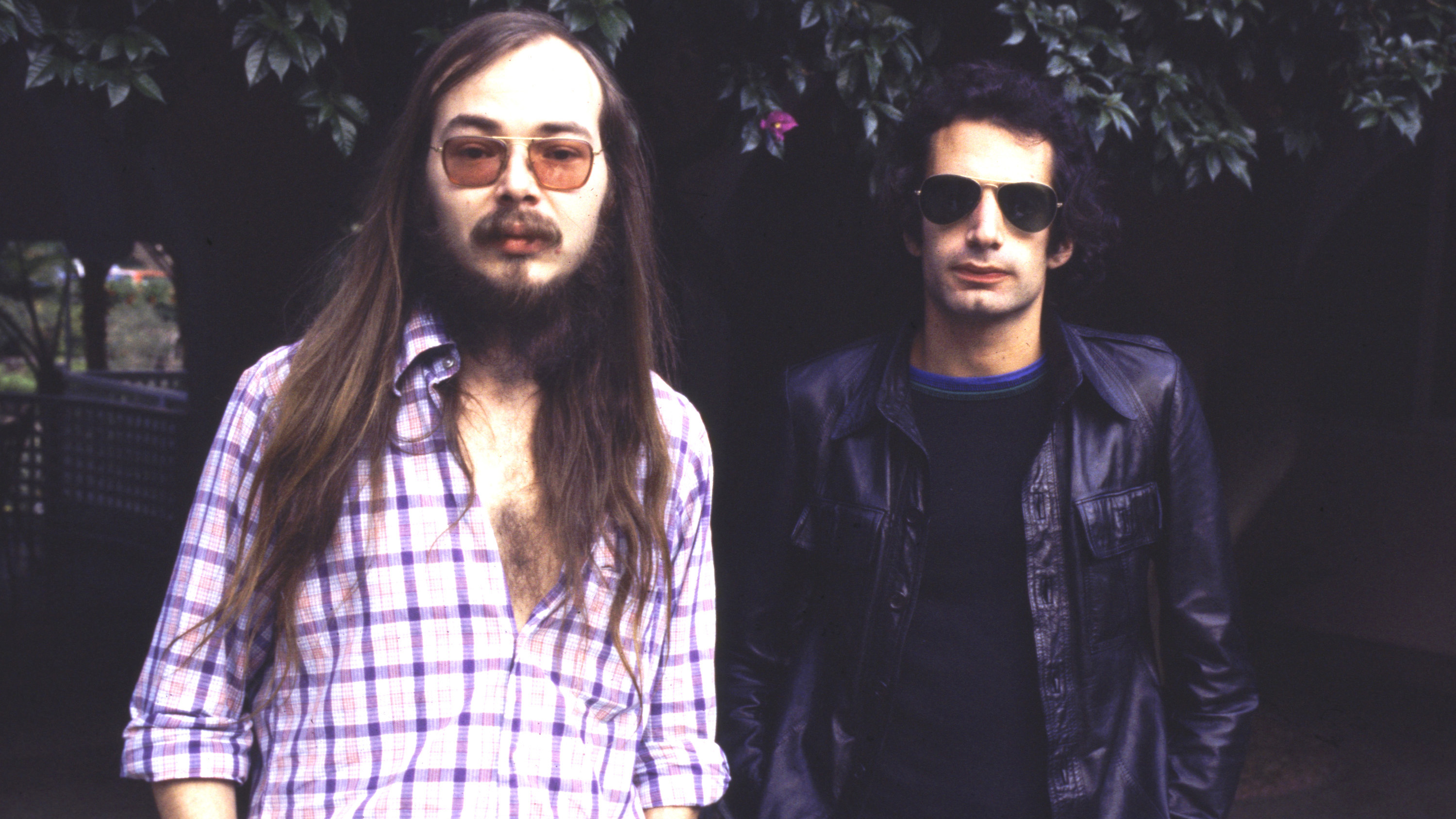5 songs you need to hear by Steely Dan: "Like a lot of kids in the ’50s, we were looking for some kind of alternative culture, an escape from where we found ourselves"
Across nine studio albums, jazz-loving perfectionists Walter Becker and Donald Fagen created a stunning body of work. Here are five of their finest moments

Few bands have inspired such cult-like adoration among musicians as Steely Dan, a band founded in 1971 by the songwriting duo of Walter Becker (guitars, bass, backing vocals) and Donald Fagen (keyboards, lead vocals). From their first meeting in 1967 as students at Bard College in upstate New York, the two jazz-loving hipsters defied rock and roll convention, rejecting hippiedom and the slog of the live circuit, immersing themselves instead in the studio to craft sublimely cool and sophisticated music.
In their early days, they were a tight, cohesive five-piece band, featuring the twin Telecaster attack of Denny Dias and Jeff ‘Skunk’ Baxter. But by their third album, Becker and Fagen were hiring a stellar array of session musicians, such as guitarists Larry Carlton and Elliott Randall; drummers Jeff Porcaro, Bernard Purdie and Steve Gadd; and horn players Wayne Shorter and Phil Woods.
The duo were not precious about their own instrumental contributions. “It wouldn’t bother me at all not to play on my own album,” Becker told journalist Cameron Crowe in 1977.
Jazz, R&B, soul and funk pervaded their songs, with their often complex time signatures, peerless grooves and sophisticated chord inversions complementing accessible hooks. Lyrically, the songs were populated by loser characters on the margins of society. The tone is cynical and cryptic, with black humour running throughout.
In the studio, Becker and Fagen were notoriously demanding. Mark Knopfler recalled being invited to play the solo on the track Time Out Of Mind on the 1980 album Gaucho. The Dire Straits frontman recorded ten hours of guitar, of which only 15 seconds was used, on the intro. Fagen and Becker were allegedly critical of Knopler’s work. “It was a strange experience,” Knopfler recalled. “Like getting into a swimming pool with lead weights tied to your boots.”
But such perfectionism yielded astonishing results. Across nine studio albums and 21 singles, Becker and Fagen created a hugely eclectic body of work that is as sublime and timeless as it is utterly unique.
Reelin’ In The Years – Can’t Buy Me A Thrill (1972)
Some Steely Dan aficionados have dismissed this hit single as one of their lesser compositions. It’s a view shared by Becker and Fagen who described it as “dumb but effective” and “no fun”.
Get the MusicRadar Newsletter
Want all the hottest music and gear news, reviews, deals, features and more, direct to your inbox? Sign up here.
But it remains one of the greatest rock songs of the 1970s, an exhilarating, soaring track that still sounds fresh five decades on. Lyrically, it’s a biting, sardonic put-down of an ex. “You've been telling me you're a genius since you were seventeen / In all the time I've known you I still don't know what you mean.”
It’s a bouncy, infectious shuffle, with piano at the fore and delivered with urgency and conviction. But it’s the dazzling, masterful guitar solo from session ace Elliott Randall that elevates it to real heights.
The solo has everything, from definable melodic hooks to dynamic, grinding unbridled highs.
“Most of the song was already complete,” Randall told Guitar World magazine in 2007. “So I had the good fortune of having a very clear picture of what the solo was laying on top of."
The guitar he used on the session was a Strat, which he had owned since 1965, with a PAF humbucker in the neck position. The set-up was simple, with Randall plugging into an Ampeg SVT bass amp, which was mic’d with a single AKG 414.
“We did it in one take and nothing was written," remembered Randall. "Jeff Baxter played the harmony parts, but my entire lead – intro, answers, solo/, end solo – was one continuous take… The whole solo just came to me, and I feel very fortunate to have been given the opportunity to play it.”
Jimmy Page reportedly said Randall’s solo on Reelin’ was his favourite guitar solo of all time, with the Led Zep guitarist awarding it a 12/10 score.
When Steely Dan hit the road, their live guitarists Jeff ‘Skunk’ Baxter and Denny Dias would also lend their own blend of sparkle to the solo.
2. Rikki Don’t Lose That Number – Pretzel Logic (1974)
This opening track from Steely Dan’s third album Pretzel Logic was the most successful single in the band’s career, reaching No. 4 in the Billboard Hot 100 chart. The memorable E to B opening piano riff was allegedly lifted from Horace Silver’s jazz classic Song For My Father, on the Blue Note label.
The 30-second intro features the flapamba, an obscure percussion instrument, which sounds more like a muted marimba. This was played by Victor Feldman, whose multi-instrumental talents helped add numerous sonic layers to Steely Dan’s best work.
Becker and Fagen’s reputation for cryptic lyrics prompted a theory that the ‘number’ in the title referred to marijuana, but Fagen and Becker have both firmly denied this. It’s essentially a straightforward love song, inspired by Fagen’s unsuccessful attempt to seduce the wife of a college professor when he was a student at Bard College.
There’s a strong Latin flavour to the choruses on the song and the whole thing flies when Jeff ‘Skunk’ Baxter’s guitar solo kicks in at 2:37. It’s a stunning piece of playing, with impeccable phrasing and a real fluidity throughout. Opinions vary on whether he used his Strat or Tele for the solo although it seems highly likely that he simply plugged into a DI box and recorded straight into the studio’s mixing desk.
There’s some beautiful piano, courtesy of Michael Omartian, while the late Jim Gordon is the drummer whose tasteful restraint steers this timeless track along.
3. Peg – Aja (1977)
An instant classic from the Aja album that went on to reach No. 12 in the Billboard charts album when released as a single in November 1977. It’s a breezy composition with a slick, slinky groove and heaps of infectious hooks.
A descending chromatic chord sequence intros the track, while the verses feature classic Steely Dan jazz shapes – major triad chords with altered bass notes. Vocalist, songwriter and keyboardist Michael McDonald provides the thickly-layered soulful harmonies.
Chuck Rainey’s bass swoops and dives seamlessly within the groove, while Paul Griffin’s Fender Rhodes adds a lush, spacious soundscape. The song's guitar solo was attempted by seven top studio session guitarists – including Robben Ford and Larry Carlton – but it was Jay Graydon’s solo, played on his 1963 Gibson 335, that became the ‘keeper’. It’s a stunning solo, with inspirational phrasing and bends. Graydon worked on the solo for six hours before Becker and Fagen were finally satisfied.
“Fortunately, I had no problems on sessions as to nailing a part,” recalled Graydon to No Echo magazine in 2014, “but know this – every first-call studio guitarist that has played solos has been replaced by another guitarist at least once. It's just part of being a studio musician.”
Many believed the track is about doomed 1920s Hollywood actress Peg Entwhistle, but Fagen blew that theory out of the water. "There's no hidden meaning,” he told The Wall Street Journal bluntly in 2020. “We just wanted a dotted half note for that spot and Peg was short enough to fit with the music."
4. Deacon Blues – Aja (1977)
According to Walter Becker, the lyrical subject of this track is a suburban “triple-L loser” dreaming of a freer, edgier life as a jazz saxophonist. “About as close to an autobiography as our tunes get,” claimed Donald Fagen in a Classic Albums documentary on Aja, the 1977 album that yielded Deacon Blues. “We were both kids who grew up in the suburbs, we both felt fairly alienated. Like a lot of kids in the ’50s, we were looking for some kind of alternative culture, an escape from where we found ourselves.”
As ever, Becker and Fagen were perfectionists in the studio and hired some of the finest session players around, such as guitarist Larry Carlton, whose crisp playing elevates the track. Carlton used his trademark Gibson ES-335 and Fender Tweed set-up.
The distinctive 12-second intro on the track features Carlton and piano player Victor Fledman playing the same sustained chords, which were layered together over drummer Bernard Purdie’s cymbals.
Becker and Fagen decided the track needed a tenor sax solo and brought in saxophonist Pete Christlieb, who was playing at the time with the house band on Johnny Carson’s Tonight Show. After taping the Carson show one evening, Christlieb met Becker and Fagen at Village Recorders studios in west Los Angeles.
“They told me to play what I felt,” Christlieb told The Wall Street Journal in September, 2015. “Hey, I'm a jazz musician, that's what I do ... so I recorded my first solo ... we listened back and they said it was great. I recorded a second take and that's the one they used. I was gone in a half hour. The next thing I know I'm hearing myself in every airport bathroom in the world.”
5. Do It Again – Can’t Buy Me A Thrill (1972)
Released as a single from their debut album, this was the band’s breakthrough hit in the US and UK, when released in November 1972. Steely Dan seemed to come from nowhere and sounded like no-one else. In a fevered bid to define their sound the press dubbed them ‘smart rock’.
A lush electric piano riff in G minor intros the 125bpm track and is a defining motif throughout. Donald Fagen took lead vocals on the studio version but David Palmer fronted the band in live settings, such as when they played the Midnight Special show in the clip above from February 1973.
The first instrumental break features a stunning electric sitar solo, played by Denny Dias. This is followed by an organ solo from Donald Fagen, played on what was described in the album’s liner notes as "an inexpensive, imported plastic organ”. This turned out to be the Yamaha YC-30, with a sliding pitch bend control.
Lyrically, it’s a karmic, cautionary tale of a gambling loser who never learns his lesson. “You go back, Jack, do it again, wheel turnin' 'round and 'round / You go back, Jack, do it again.”

Neil Crossley is a freelance writer and editor whose work has appeared in publications such as The Guardian, The Times, The Independent and the FT. Neil is also a singer-songwriter, fronts the band Furlined and was a member of International Blue, a ‘pop croon collaboration’ produced by Tony Visconti.



![PRS Archon Classic and Mark Tremonti MT 15 v2: the newly redesigned tube amps offer a host of new features and tones, with the Alter Bridge guitarist's new lunchbox head [right] featuring the Overdrive channel from his MT 100 head, and there's a half-power switch, too.](https://cdn.mos.cms.futurecdn.net/FD37q5pRLCQDhCpT8y94Zi.jpg)





